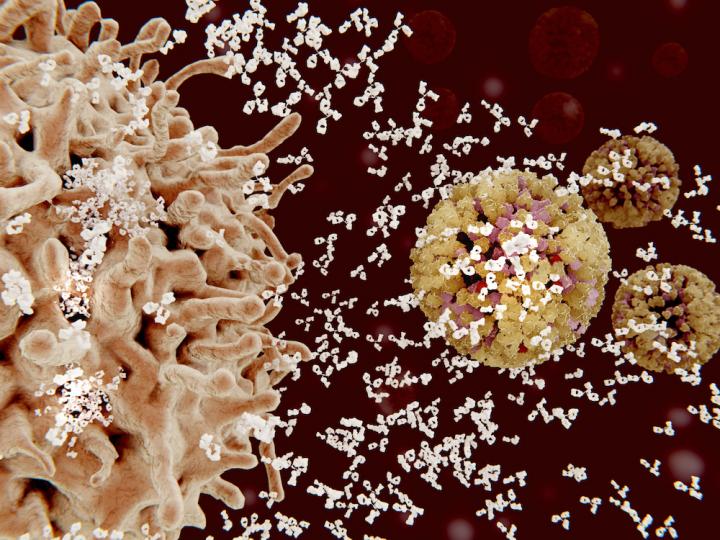If a bone breaks or a tendon snaps, you know to seek treatment immediately. But your most fragile and precious cellular commodity, chromosomal DNA, breaks with astounding frequency–some estimate as many as 10,000 times a day per cell–usually without consequence. That’s because legions of DNA repair proteins prevent genomic catastrophe by repairing DNA damaged by chemical or physical mutagens or just normal cellular wear and tear. Proteins dedicated to these tasks are common to all species. In fact, life as we (or bacteria) know it cannot exist without proteins dedicated to DNA repair.
New work from the lab of La Jolla Institute for Immunology (LJI) investigator Anjana Rao, Ph.D., reveals a previously unrecognized activity for one DNA repair factor highly conserved through evolution. In a study published in the Dec. 2, 2019, issue of Molecular Cell, they report that mouse lymphocytes engineered to lack that protein (known as HMCES and pronounced Hem’-sez) cannot recombine their DNA in a manner necessary to make new classes of antibodies, called Immunoglobulins G or A (IgG or IgA).

That finding means that HMCES, previously reported to repair nicks in single DNA strands, also participates in what is called alternative end joining, which as its name suggests is a secondary strategy used by mammalian cells to rejoin severe cuts across both strands of the double helix. These and other recent reports suggest that a humble DNA repair factor whose history likely dates back at least three billion years performs multiple tasks to guard cells against genomic instability.
“When activated, normal B lymphocytes snip out a DNA segment that encodes antibodies called IgM and then reconnect the strand in order to make other more potent classes of antibodies,” says Vipul Shukla, Ph.D., the study’s first author, describing a DNA editing trick that immunologists call class switch recombination (CSR). “People have known for decades that immune cells use this kind of gene editing as a way to make potent antibodies. We found that HMCES not only recognizes these double strand breaks but helps reseal them.”
[ad_336]
The Rao lab, which first reported and since then has extensively studied has recently focused on DNA-modifying epigenetic regulators called TET proteins, became interested in HMCES because it had been reported to bind to DNA chemically modified by TET. Reasoning that HMCES and TET proteins might be engaged in similar biological tasks, they genetically “knocked out” the HMCES gene in experimental mice, predicting that animals would display blood cell defects or even cancer, outcomes often associated with TET gene mutations. Surprisingly, that didn’t happen: the new paper reports that blood cells from HMCES-deficient mice were normal and showed little disruption in TET-dependent DNA modifications.
However, the fact that normal, activated B lymphocytes express abundant RNA encoding HMCES prompted the group to compare immune responses in HMCES-deficient versus normal adult B cells. Following antigen stimulation, normal B cells predictably “switch” their antibody repertoire from IgM to IgG antibodies. By contrast, lymphocytes from HMCES-deficient mice were less efficient at making IgG antibodies, presumably because the CSR machinery that “recombines” DNA to convert IgM to other IgG isotypes is less operational without HMCES.
“In this study we used lymphocytes as a model system to identify a new role for HMCES in a lesser-known pathway of DNA double-strand break repair,” says Shukla, referring to alternative end-joining. “But that pathway is not only active in immune cells. The kind of DNA double-stranded break repair we describe here likely occurs in response to DNA damage in any cell of the body.”
The new study provides evidence that HMCES is versatile enough to accomplish entirely different tasks in response to DNA damage, depending on need. For example, in an earlier study, University of Toronto collaborators Levon Halabelian, Ph.D., and Cheryl Arrowsmith, Ph.D., showed how HMCES can carry out these multiple roles in the cell by determining the 3D structure of HMCES bound to several types of ‘broken’ DNA strands. In the current study, their structures revealed how HMCES can also orchestrate the alternative end joining activities in B cells. Others reported that in some contexts HMCES shields damaged single-stranded DNA from further degradation.
[rand_post]
Moreover, HMCES is the only human protein that contains a domain conserved in the bacterial protein YedK, which participates in repair of E. coli DNA. Senior co-author L. Aravind, Ph.D., of the National Center for Biotechnology Information and National Library of Medicine (NCBI, NLM) notes that these findings hint that in the course of evolution, HMCES-like proteins acquired the capacity to recognize and respond appropriately to diverse signs of genomic distress.
“Many DNA repair proteins have ancient origins,” he says. “HMCES adds to that repertoire and shows that mammalian cells have recruited repair strategies from bacteria to mediate DNA joining in a physiological double strand-break repair mechanism, in this case CSR.”
Shukla concurs: “Nature has clearly found a way to use this extremely important protein to promote the well-being of many organisms.”